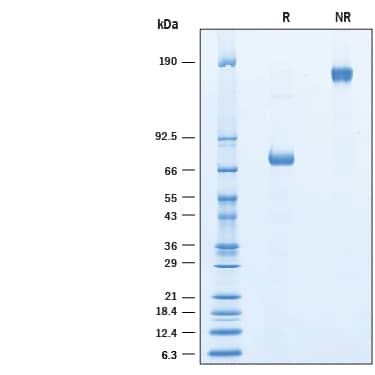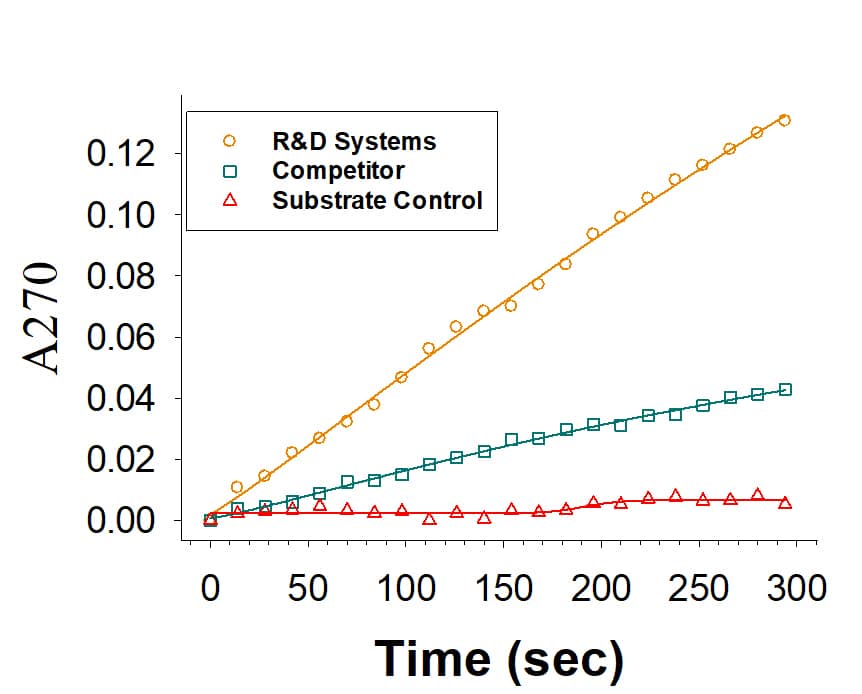Recombinant Human PON1 His-tag Fc Chimera Protein, CF
R&D Systems, part of Bio-Techne | Catalog # 10175-PO

Key Product Details
Product Specifications
Source
Human embryonic kidney cell, HEK293-derived human PON1 protein
Leu16-Leu355
with an N-terminal 6-His tag and a C-terminal Fc tag
Leu16-Leu355
with an N-terminal 6-His tag and a C-terminal Fc tag
Purity
>95%, by SDS-PAGE visualized with Silver Staining and quantitative densitometry by Coomassie® Blue Staining.
Endotoxin Level
<1.0 EU per 1 μg of the protein by the LAL method.
N-terminal Sequence Analysis
His
Predicted Molecular Mass
66 kDa
SDS-PAGE
69-79 kDa, under reducing conditions
Activity
Measured by its ability to hydrolyze phenyl acetate.
The specific activity is >5000 pmol/min/μg, as measured under the described conditions.
The specific activity is >5000 pmol/min/μg, as measured under the described conditions.
Scientific Data Images for Recombinant Human PON1 His-tag Fc Chimera Protein, CF
Recombinant Human PON1 His-tag Fc Chimera Protein Enzyme Activity
Recombinant Human PON-1 His-tag Fc Chimera (Catalog # 10175-PO) is measured by its ability to hydrolyze phenyl acetate. The activity (orange) is over 3-fold higher than the competitor's PON-1 (green).Recombinant Human PON1 His-tag Fc Chimera Protein SDS-PAGE
2 μg/lane of Recombinant Human PON1 His-tag Fc Chimera was resolved with SDS-PAGE under reducing (R) and non-reducing (NR) conditions and visualized by Coomassie® blue staining, showing a band at ~74 kDa under reducing conditions.Formulation, Preparation and Storage
10175-PO
| Formulation | Supplied as a 0.2 μm filtered solution in Tris, CaCl2, NaCl, and Glycerol. |
| Shipping | The product is shipped with polar packs. Upon receipt, store it immediately at the temperature recommended below. |
| Stability & Storage | Use a manual defrost freezer and avoid repeated freeze-thaw cycles.
|
Background: PON1
References
- Dragonov, D. I. et al. (2005) Lipid Res. 46:1239.
- Khersonsky, O. et al. (2005) Biochemistry. 44:6371.
- Ben-David, M. et al. (2012) J. Mol. Biol. 418:181.
- Harel, M. et al. (2004) Nature Struct. Mol. Biol. 11:412.
- Mackness, B. et al. (1998) Gen. Pharmac. 31:329.
- Aviram, M. et al. (2004) Free Radic. Biol. Med. 37:1304.
- Rozenberg, O. et al. (2008) Free Radic. Biol. Med. 44:1951.
- Koren-Gluzer, M. et al. (2011) Atherosclerosis. 219:532.
- Goswami, N. et al. (2009) Clin. Chim. Acta. 410:1.
- Mahrooz, A. (2016) Curr. Clin. Pharmacol. 11:259.
- Berrougui, H. et al. (2012) Free Radic. Biol. Med. 52:1372.
- Aharoni, S. et al. (2013) Atherosclerosis 228:353.
- Tavori, H. (2011) Free Rad. Biol. Med. 51:234.
- Wang, M. et al. (2012) DNA Cell. Biol. 31:975.
- Tang, W. H. W. et al. (2012) Arterioscler. Thromb. Vasc. Biol. 32:2803.
- Li, W. F. et al. (2000) Pharmacogenetics. 10:767.
- Shih, D. M. et al. (1998) Nature. 394:284.
- Ahmed, H. et al. (2017) Biomed. Pharmacother. 90:638.
- Gagliardi, S. et al. (2013) Neurotox. Res. 23:370.
Long Name
Paraoxonase 1
Alternate Names
ESA, K-45
Gene Symbol
PON1
UniProt
Additional PON1 Products
Product Documents for Recombinant Human PON1 His-tag Fc Chimera Protein, CF
Product Specific Notices for Recombinant Human PON1 His-tag Fc Chimera Protein, CF
For research use only
